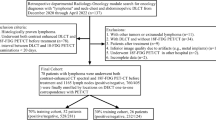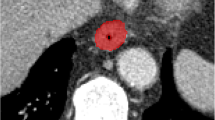Abstract
Objectives
Multicentre evaluation of the precision of semi-automatic 2D/3D measurements in comparison to manual, linear measurements of lymph nodes regarding their inter-observer variability in multi-slice CT (MSCT) of patients with lymphoma.
Methods
MSCT data of 63 patients were interpreted before and after chemotherapy by one/tworadiologists in five university hospitals. In 307 lymph nodes, short (SAD)/long (LAD) axis diameter and WHO area were determined manually and semi-automatically. Volume was solely calculated semi-automatically. To determine the precision of the individual parameters, a mean was calculated for every lymph node/parameter. Deviation of the measured parameters from this mean was evaluated separately. Statistical analysis entailed intraclass correlation coefficients (ICC) and Kruskal–Wallis tests.
Results
Median relative deviations of semi-automatic parameters were smaller than deviations of manually assessed parameters, e.g. semi-automatic SAD 5.3 vs. manual 6.5 %. Median variations among different study sites were smaller if the measurement was conducted semi-automatically, e. g. manual LAD 5.7/4.2 % vs. semi-automatic 3.4/3.4 %. Semi-automatic volumetry was superior to the other parameters (2.8 %).
Conclusions
Semi-automatic determination of different lymph node parameters is (compared to manually assessed parameters) associated with a slightly greater precision and a marginally lower inter-observer variability. These results are with regard to the increasing mobility of patients among different medical centres and in relation to the quality management of multicentre trials of importance.
Key Points
• In a multicentre setting, semi-automatic measurements are more accurate than manual assessments.
• Lymph node volumetry outperforms all other semi-automaticallyand manually performed measurements.
• Use of semi-automatic lymph node analyses can reduce the inter-observer variability.




Similar content being viewed by others
References
Eisenhauer EA, Therasse P, Bogaerts J etal (2009) New response evaluation criteria in solid tumours: revised RECIST guideline (version 1.1). Eur J Cancer 45:228–247
Cheson B, Horning SJ, Coiffier B etal (1999) Report of an international workshop to standardize response criteria for non-Hodgkin’s lymphomas. NCI Sponsored International Working Group. J Clin Oncol 17:1244–1253
Assouline S, Meyer RM, Infante-Rivard C etal (2007) Development of adapted RECIST criteria to assess response in lymphoma and their comparison to the International Workshop Criteria. Leuk Lymphoma 48:513–520
Jaffe TA, Wickersham NW, Sullivan DC (2010) Quantitative imaging in oncology patients: Part 1, radiology practice patterns at major US cancer centers. AJR Am J Roentgenol 195:101–106
van Persijn, van Meerten EL, Gelderblom H, Bloem JL (2010) RECIST revised: implications for the radiologist. A review article on the modified RECIST guideline. Eur Radiol 20:1456–1467
Miller AB, Hoogstraten B, Staguet M, Winkler A (1981) Reporting results of cancer treatment. Cancer 47:207–214
Weßling J, Puesken M, Koch R etal (2012) MSCT follow-up in malignant lymphoma: comparison of manual linear measurements with semi-automated lymph node analysis for therapy response classification. Röfo 184:795–804
Buerke B, Gerss J, Puesken M, Weckesser M, Heindel W, Wessling J (2011) Usefulness of semi-automatic volumetry compared to established linear measurements in predicting lymph node metastases in MSCT. Acta Radiol 52:540–546
Buerke B, Puesken M, Müter S etal (2010) Measurement accuracy and reproducibility of semiautomated metric and volumetric lymph node analysis in MDCT. AJR Am J Roentgenol 195:979–985
Buerke B, Puesken M, Beyer F etal (2010) Semiautomatic lymph node segmentation in multislice computed tomography: impact of slice thickness on segmentation quality, measurement precision, and interobserver variability. Investig Radiol 45:82–88
Kuhnigk JM, Dicken V, Bornemann L etal (2006) Morphological segmentation and partial volume analysis for volumetry of solid pulmonary lesions in thoracic CT. IEEE Trans Med Imaging 25:417–434
James K, Eisenhauer E, Christian M etal (1999) Measuring response in solid tumors: unidimensional versus bidimensional measurement. J Natl Cancer Inst 91:523–528
Fabel M, von Tengg-Kobligk H, Giesel FL etal (2008) Semi-automated volumetric analysis of lymph node metastases in patients with malignant melanoma stage III/IV – a feasibility study. Eur Radiol 18:1114–1122
Zhao B, Schwartz LH, Moskowitz CS, Ginsberg MS, Rizvi NA, Kris MG (2006) Lung cancer: computerized quantification of tumor response – initial results. Radiology 241:892–898
Jaffe TA, Wickersham NW, Sullivan DC (2010) Quantitative imaging in oncology patients: Part 2, oncologists’ opinions and expectations at major US cancer centers. AJR Am J Roentgenol 195:W19–W30
Wulff AM, Bolte H, Fischer S etal (2012) Lung, liver and lymph node metastases in follow-up MSCT: comprehensive volumetric assessment of lesion size changes. Röfo 184:820–828
Quantitative Imaging Biomarkers Alliance (QIBA) of the Radiological Society of North America (RSNA) (2007) QIBA Mission. Radiological Society of North America (RSNA), Oak Brook (IL), USA. Available via http://rsna.org/QIBA.aspx. Accessed 15 Nov 2013
Puesken M, Buerke B, Gerss J etal (2010) Prediction of lymph node manifestations in malignant lymphoma: significant role of volumetric compared with established metric lymph node analysis in multislice computed tomography. J Comput Assist Tomogr 34:564–569
Cortes J, Rodriguez J, Diaz-Gonzalez JA etal (2002) Comparison of unidimensional and bidimensional measurements in metastatic non-small cell lung cancer. Br J Cancer 87:158–160
Frank R, Hargreaves R (2003) Clinical biomarkers in drug discovery and development. Nat Rev Drug Discov 2:566–580
Wormanns D, Kohl G, Klotz E etal (2004) Volumetric measurements of pulmonary nodules at multi-row detector CT: invivo reproducibility. Eur Radiol 14:86–92
McErlean A, Panicek DM, Zabor EC etal (2013) Intra- and interobserver variability in CT measurements in oncology. Radiology 269:451–459
Clarke LP, Croft BS, Nordstrom R, Zhang H, Kelloff G, Tatum J (2009) Quantitative imaging for evaluation of response to cancer therapy. Transl Oncol 2:195–197
Quantitative Imaging Network (QIN) of the National Cancer Institute (NCI) (2011) Quantitative imaging for evaluation of responses to cancer therapies (U01). Available via http://grants.nih.gov/grants/guide/pa-files/PAR-08-225.html. Accessed 15 Nov 2013
Acknowledgments
The scientific guarantor of this publication is Dr. Boris Buerke, MD, PhD. The authors of this manuscript declare no relationships with any companies whose products or services may be related to the subject matter of the article. The authors state that this work has not received any funding. One of the authors (Dr. Raphael Koch) has significant statistical expertise. Institutional review board approval was obtained. Written informed consent was obtained from all subjects (patients) in this study. Some study subjects or cohorts have been previously reported in one published paper and one paper under review.
Methodology: retrospective, multicenter study
Author information
Authors and Affiliations
Corresponding author
Rights and permissions
About this article
Cite this article
Höink, A.J., Weßling, J., Koch, R. et al. Comparison of manual and semi-automatic measuring techniques in MSCT scans of patients with lymphoma: a multicentre study. Eur Radiol 24, 2709–2718 (2014). https://doi.org/10.1007/s00330-014-3283-x
Received:
Revised:
Accepted:
Published:
Issue Date:
DOI: https://doi.org/10.1007/s00330-014-3283-x




